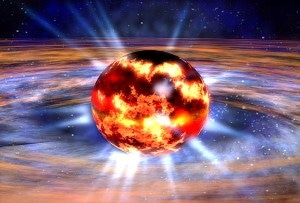Aug 7 2017
Astronomers believe that we are the byproducts of stars, stellar furnaces that fused helium and hydrogen long ago into the elements necessary for life through the stellar nucleosynthesis process.
 Artist’s depiction of a neutron star. Credit: NASA
Artist’s depiction of a neutron star. Credit: NASA
The nitrogen in our DNA, the calcium in our teeth, the iron in our blood, the carbon in our apple pies were made in the interiors of collapsing stars. We are made of star stuff.
Carl Sagan, Late Astronomer
But what about the heavier components in the periodic chart, components such as uranium, platinum and gold?
Astronomers consider that most of these “r-process elements”—elements that are much heavier compared to iron—have been formed, either after the collapse of large stars and the related supernova explosions, or within the merging of binary neutron star systems.
A different kind of furnace was needed to forge gold, platinum, uranium and most other elements heavier than iron. These elements most likely formed in an environment rich with neutrons.
George Fuller, a Theoretical Astrophysicist, Professor of Physics and Director, the Center for Astrophysics and Space Sciences, UC San Diego
In a paper published in the journal Physical Review Letters on August 7th, Fuller and two other Theoretical Astrophysicists at UCLA, Volodymyr Takhistovs and Alex Kusenko, provide another way by which stars could have generated these heavy elements: small black holes that came into contact with and are captured by neutron stars, and after that destroy them.
Neutron stars are the tiniest and densest stars known in the universe, and they are so dense that a spoonful of their surface has a corresponding mass of three billion tons.
Although small black holes are more speculative, many astronomers consider that they could be a byproduct of the Big Bang and they could even frame some fraction of the “dark matter”—the invisible, nearly non-interacting substance that observations reveal exists in the universe.
If these small black holes follow dark matter’s distribution in space and co-exist with neutron stars, Fuller and his collaborators challenge in their paper that some fascinating physics would occur.
They determine that a neutron star will capture such a black hole in rare instances and then devoured from the inside out by it. This aggressive process could cause the ejection of some of the solid neutron-star matter into space.
Small black holes produced in the Big Bang can invade a neutron star and eat it from the inside. In the last milliseconds of the neutron star's demise, the amount of ejected neutron-rich material is sufficient to explain the observed abundances of heavy elements.
George Fuller, a Theoretical Astrophysicist, Professor of Physics and Director, the Center for Astrophysics and Space Sciences, UC San Diego
“As the neutron stars are devoured,” he added, “they spin up and eject cold neutron matter, which decompresses, heats up and make these elements.” This process of making the heaviest elements of the periodic table would also give explanations for several other unresolved puzzles in the universe and within the Milky Way galaxy.
“Since these events happen rarely, one can understand why only one in ten dwarf galaxies is enriched with heavy elements,” said Fuller. “The systematic destruction of neutron stars by primordial black holes is consistent with the paucity of neutron stars in the galactic center and in dwarf galaxies, where the density of black holes should be very high.”
Additionally, the Researchers determined the ejection of nuclear matter from the small black holes devouring neutron stars would create three other unexplained phenomenon observed by Astronomers.
“They are a distinctive display of infrared light (sometimes termed a “kilonova”), a radio emission that may explain the mysterious Fast Radio Bursts from unknown sources deep in the cosmos, and the positrons detected in the galactic center by X-ray observations,” said Fuller.
“Each of these represent long-standing mysteries. It is indeed surprising that the solutions of these seemingly unrelated phenomena may be connected with the violent end of neutron stars at the hands of tiny black holes.” Funding for this project was provided by the National Science Foundation (PHY-1614864) at UC San Diego and by the U.S. Department of Energy (DE-SC0009937) at UCLA. Alex Kusenko was also supported, in part, by the World Premier International Research Center Initiative (WPI), MEXT, Japan.